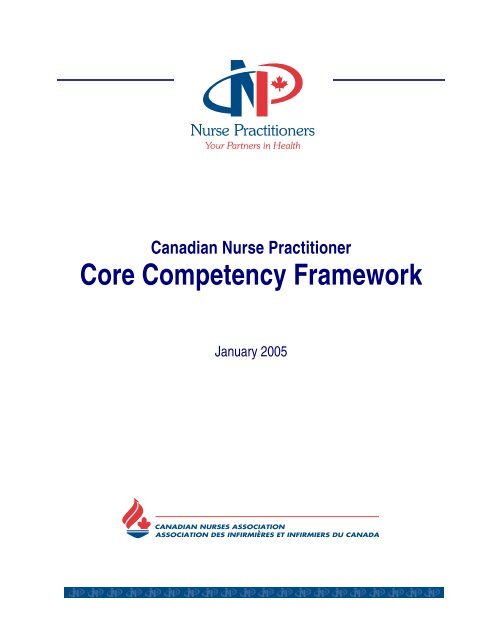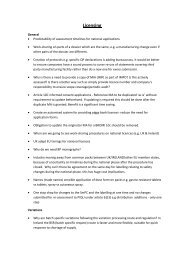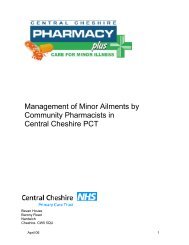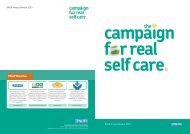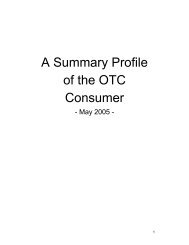Canadian Nurse Practitioner Core Competency Framework
Canadian Nurse Practitioner Core Competency Framework
Canadian Nurse Practitioner Core Competency Framework
You also want an ePaper? Increase the reach of your titles
YUMPU automatically turns print PDFs into web optimized ePapers that Google loves.
<strong>Canadian</strong> <strong>Nurse</strong> <strong>Practitioner</strong><br />
<strong>Core</strong> <strong>Competency</strong> <strong>Framework</strong><br />
January 2005
Table of Contents<br />
Preface ........................................................................................................ 1<br />
Acknowledgments ...................................................................................... 2<br />
Introduction................................................................................................ 3<br />
Assumptions ............................................................................................... 4<br />
Competencies.............................................................................................. 5<br />
I. Health Assessment and Diagnosis........................................................ 5<br />
II. Health-Care Management and Therapeutic Intervention ..................... 7<br />
III. Health Promotion and Prevention of Illness, Injury<br />
and Complications................................................................................ 10<br />
IV. Professional Role and Responsibility................................................... 11<br />
Glossary of Terms...................................................................................... 13<br />
<strong>Canadian</strong> <strong>Nurse</strong> <strong>Practitioner</strong> <strong>Core</strong> <strong>Competency</strong> <strong>Framework</strong><br />
i
All rights reserved.<br />
No part of this document may be reproduced, stored in a retrieval system, or transcribed,<br />
in any form or by any means, electronic, mechanical, photocopying, recording,<br />
or otherwise, without written permission of the publisher.<br />
© <strong>Canadian</strong> <strong>Nurse</strong>s Association<br />
50 Driveway<br />
Ottawa ON K2P 1E2<br />
Tel.: (613) 237-2133 or 1-800-361-8404<br />
Fax: (613) 237-3520<br />
Website: www.cna-aiic.ca<br />
ISBN 1-55119-950-5<br />
January 2005
Preface<br />
The <strong>Canadian</strong> <strong>Nurse</strong>s Association (CNA) is pleased to present the <strong>Canadian</strong> <strong>Nurse</strong> <strong>Practitioner</strong><br />
<strong>Core</strong> <strong>Competency</strong> <strong>Framework</strong>, which was developed and validated over the period of 2002-2004.<br />
The development of the framework represents a major milestone in the evolution of the nurse<br />
practitioner role in Canada. Despite more than three decades of history in the nurse practitioner<br />
movement, this is the first time that delineation and consensus on core competencies for nurse<br />
practitioners have been achieved.<br />
The provincial/territorial regulatory authorities participated in all phases of identifying,<br />
developing and validating the comprehensive competencies expected of the entry-level nurse<br />
practitioner. These competencies were further validated by an extensive survey asking nurse<br />
practitioners, educators, employers, physicians, registered nurses and other key stakeholders to<br />
identify the competencies required for safe and effective practice of entry-level nurse<br />
practitioners in Canada. The competencies and validation data enable the description of the<br />
essential components of a <strong>Canadian</strong> <strong>Nurse</strong> <strong>Practitioner</strong> Examination (CNPE).<br />
The competencies will be subjected to periodic comprehensive reviews to ensure their continuing<br />
validity. Because of the changes that occur in nurse practitioner practice, a validation study of<br />
the competencies will be conducted at least every five years. In addition, the competencies will<br />
be reviewed and evaluated annually by content experts.<br />
CNA welcomes feedback to help inform future reviews and revisions of the <strong>Canadian</strong> <strong>Nurse</strong><br />
<strong>Practitioner</strong> <strong>Core</strong> <strong>Competency</strong> <strong>Framework</strong>. Please forward feedback to:<br />
Director, Regulatory Policy<br />
<strong>Canadian</strong> <strong>Nurse</strong>s Association<br />
50 Driveway<br />
Ottawa, ON K2P 1E2<br />
<strong>Canadian</strong> <strong>Nurse</strong> <strong>Practitioner</strong> <strong>Core</strong> <strong>Competency</strong> <strong>Framework</strong> 1
Acknowledgments<br />
CNA thanks all who have contributed to the development of the <strong>Canadian</strong> <strong>Nurse</strong> <strong>Practitioner</strong><br />
<strong>Core</strong> <strong>Competency</strong> <strong>Framework</strong>. In particular, thanks are extended to the regulatory authorities,<br />
the CNPE <strong>Core</strong> <strong>Competency</strong> Review Committee, nurse practitioners and all other stakeholders<br />
across Canada who responded to the competency validation survey.<br />
The development of the framework was also made possible by the collaborative efforts of the<br />
following organizations:<br />
• Association of Registered <strong>Nurse</strong>s of Newfoundland and Labrador<br />
• Association of <strong>Nurse</strong>s of Prince Edward Island<br />
• College of Registered <strong>Nurse</strong>s of Nova Scotia<br />
• <strong>Nurse</strong>s Association of New Brunswick<br />
• Registered <strong>Nurse</strong>s Association of Ontario<br />
• College of <strong>Nurse</strong>s of Ontario<br />
• College of Registered <strong>Nurse</strong>s of Manitoba<br />
• Saskatchewan Registered <strong>Nurse</strong>s’ Association<br />
• Alberta Association of Registered <strong>Nurse</strong>s<br />
• Registered <strong>Nurse</strong>s Association of British Columbia<br />
• Registered <strong>Nurse</strong>s Association of the Northwest Territories and Nunavut<br />
• Yukon Registered <strong>Nurse</strong>s Association<br />
• First Nations and Inuit Health Branch, Health Canada<br />
• <strong>Canadian</strong> <strong>Nurse</strong>s Association<br />
• The <strong>Canadian</strong> <strong>Nurse</strong> <strong>Practitioner</strong> Initiative team<br />
2 January 2005
Introduction<br />
<strong>Nurse</strong> practitioners are registered nurses with advanced skills and knowledge in health<br />
assessment, promotion and management, as well as disease prevention. They provide essential<br />
health services, including the management of acute and chronic disease within a holistic model<br />
of care, in collaboration with clients, physicians and other health-care providers. Working<br />
autonomously and collaboratively with interdisciplinary teams, nurse practitioners provide<br />
care that involves deliberate, purposeful and reflective use of specialized knowledge and<br />
skills grounded in professional, ethical and legal standards.<br />
This document outlines the common core competencies essential to the practice of all nurse<br />
practitioners. These core competency statements describe the integrated knowledge, skills,<br />
judgment and attributes required of a nurse practitioner to practise safely and ethically in a<br />
designated role and setting, regardless of client populations or practice environments. It is<br />
understood that the core competencies herein build on the competencies required of a<br />
registered nurse. The competencies are presented within a framework of four categories that<br />
encompass the nurse practitioner’s holistic approach to health care. The four categories are<br />
as follows: Health Assessment and Diagnosis; Health-Care Management and Therapeutic<br />
Intervention; Health Promotion and Prevention of Illness, Injury and Complications; and<br />
Professional Role and Responsibility.<br />
The core competency statements are entry-level competencies, which the beginning nurse<br />
practitioner would be expected to exhibit after successful completion of a nurse practitioner<br />
education program, a program equivalency review or a prior learning assessment and<br />
recognition process. Each nurse practitioner is expected to demonstrate the core nurse<br />
practitioner competencies. These are minimum requirements. As nurse practitioners move<br />
along the continuum from novice to expert level and develop a greater depth of knowledge,<br />
they will exceed the competencies required for entry-level practice.<br />
Specific roles and competencies of nurse practitioners will be determined by their context of<br />
practice (e.g., the health needs of their client population groups; the availability and access to<br />
other health professionals, including, but not limited to, physicians and specialists; and access<br />
to clinical and community resources and other support systems). However, these competencies<br />
also apply across a broad variety of settings, including the community, specialty clinics, longterm<br />
care facilities, emergency and urgent care centres, and hospitals. The practice of nurse<br />
practitioners will continue to evolve in response to changing contexts of practice and healthcare<br />
environments.<br />
The definitions and assumptions used to develop the core competencies are essential to the<br />
understanding of how these competencies may be applied to nurse practitioner practice across<br />
Canada in a variety of settings.<br />
<strong>Canadian</strong> <strong>Nurse</strong> <strong>Practitioner</strong> <strong>Core</strong> <strong>Competency</strong> <strong>Framework</strong> 3
Assumptions<br />
1. Competencies are defined as the integrated knowledge, skills, judgment and attributes required<br />
of a nurse practitioner to practise safely and ethically in a designated role and setting.<br />
2. <strong>Nurse</strong> practitioner core competencies are common to all nurse practitioner practice and apply<br />
across all contexts of practice to meet the unique health needs of the population served.<br />
3. <strong>Nurse</strong> practitioners are registered nurses who achieve additional competencies, usually<br />
through graduate nursing education that has been consolidated through substantial clinical<br />
learning experience.<br />
4. <strong>Nurse</strong> practitioner practice reflects the essential components of primary health care, including<br />
health promotion and education, disease and injury prevention, curative care, rehabilitative<br />
care and supportive care (including palliative care).<br />
5. <strong>Nurse</strong> practitioners provide their services to clients who may be individuals, families, groups<br />
or entire communities.<br />
6. <strong>Nurse</strong> practitioners work in collaboration with a variety of health-care providers to ensure the<br />
best possible delivery of health care in Canada.<br />
7. Within the scope of practice, each nurse practitioner is accountable for practising within<br />
his/her own level of individual competence and for determining the skill set and knowledge<br />
required by unique contexts and client needs.<br />
8. <strong>Nurse</strong> practitioners must practise according to provincial or territorial standards of practice<br />
and ethical guidelines as well as the CNA Code of Ethics for Registered <strong>Nurse</strong>s.<br />
9. <strong>Nurse</strong> practitioners function autonomously within a scope of practice defined by provincial<br />
and territorial legislation and regulation.<br />
10. <strong>Nurse</strong> practitioner core competencies related to ordering diagnostic tests, establishing a<br />
diagnosis, and prescribing medications and other treatments may require additional<br />
regulation by nursing regulatory bodies.<br />
11. <strong>Nurse</strong> practitioners recognize that diversity influences the health/illness experiences of clients<br />
and their use of health-care services.<br />
4 January 2005
Competencies<br />
I. Health Assessment and Diagnosis<br />
The nurse practitioner demonstrates competence in health assessment and diagnosis by<br />
performing the following behaviours.<br />
The nurse practitioner:<br />
1.1 performs an advanced, comprehensive and focused health assessment that includes a health<br />
history and complete physical evaluation; considers the psychosocial, emotional, ethnic,<br />
cultural and spiritual dimensions of health; and involves understanding with clients the<br />
meaning of their health/illness experiences and how their daily living is affected.<br />
1.2 uses and adapts assessment tools and techniques based on the client’s unique needs.<br />
1.3 synthesizes health assessment information and uses critical thinking and clinical<br />
reasoning skills to:<br />
1.3.1 identify health concerns and risks;<br />
1.3.2 identify normal and abnormal states of health; and<br />
1.3.3 formulate differential diagnoses.<br />
1.4 in the process of making a diagnosis within the nurse practitioner scope of practice,<br />
combines client assessment findings with scientific and clinical knowledge, considering<br />
such factors as:<br />
1.4.1 developmental stages;<br />
1.4.2 behavioural sciences;<br />
1.4.3 health/illness experiences;<br />
1.4.4 pathophysiology and psychopathology;<br />
1.4.5 epidemiology and infectious diseases;<br />
1.4.6 multiple etiologies; and<br />
1.4.7 clinical manifestations of acute illness/injuries, chronic diseases, emergency<br />
health needs and normal health events.<br />
<strong>Canadian</strong> <strong>Nurse</strong> <strong>Practitioner</strong> <strong>Core</strong> <strong>Competency</strong> <strong>Framework</strong> 5
1.5 orders appropriate screening and diagnostic investigations (e.g., laboratory tests, X-rays,<br />
ultrasound) and interprets reports of these investigations based on sound clinical<br />
reasoning, scientific evidence and critical thinking.<br />
1.6 diagnoses diseases, disorders and conditions, while taking the client’s response to the<br />
illness experience into consideration.<br />
1.7 communicates with clients about health findings and/or diagnoses and discusses health<br />
outcomes and prognoses.<br />
1.8 collaborates with clients to identify and choose treatment or care options.<br />
1.9 supports and counsels clients regarding their personal responses to diseases, disorders or<br />
conditions, while creating an environment in which effective learning can take place.<br />
1.10 synthesizes client information with scientific information to identify broader implications<br />
for health within the family and community.<br />
1.11 uses family assessment tools to evaluate family strengths and needs.<br />
1.12 applies theories of family dynamics, interactions and role expectations when managing<br />
family health.<br />
1.13 documents health assessments, clinical data, findings, diagnoses, collaborations,<br />
communications and conclusions in a timely, accurate and relevant manner.<br />
1.14 initiates timely, effective consultation, collaboration and/or referral to physicians, other<br />
health-care professionals and social service providers, as appropriate, to assess and<br />
diagnose client health/illness status.<br />
1.15 anticipates and recognizes rapidly changing urgent and emergent situations.<br />
6 January 2005
II. Health-Care Management and Therapeutic Intervention<br />
The nurse practitioner demonstrates competence in health-care management and therapeutic<br />
intervention by performing the following behaviours.<br />
The nurse practitioner:<br />
2.1 collaborates with clients and, where applicable, their families and other members of the<br />
health-care team to share decision-making and set priorities for the management of<br />
diseases, disorders or conditions.<br />
2.2 intervenes appropriately by:<br />
2.2.1 using relevant knowledge about the humanities, behavioural sciences and lived<br />
human experiences to help clients adopt health practices that will achieve their<br />
desired state of wellness;<br />
2.2.2 negotiating with clients a plan of care that integrates their goals with scientific<br />
rationale and evidence-based guidelines and helping clients incorporate the plan<br />
into their daily lives;<br />
2.2.3 determining treatments and prescribing them, in writing, based on theory and<br />
evidence-based practice for the specific client population while considering<br />
active participation of clients, best outcomes and cost-effectiveness;<br />
2.2.4 advocating with or on behalf of clients to ensure their health needs are met;<br />
2.2.5 helping clients throughout the teaching/learning process to plan, follow and<br />
evaluate therapeutic regimes, including negotiating ongoing contact to assist<br />
clients to monitor and evaluate their plan of care and health/illness status;<br />
2.2.6 continually monitoring, with clients, the effect of the chosen treatment plan –<br />
which may include a range of complementary and alternative interventions – and<br />
making adjustments as indicated;<br />
2.2.7 using sound clinical reasoning skills and established outcome criteria to evaluate<br />
the initial and ongoing outcomes of the plan of care, including consultation/<br />
referral; and<br />
2.2.8 documenting the plan of care, including consultation/referral, the client’s health<br />
status, and the outcomes of the plan of care, in a timely, accurate and relevant<br />
manner.<br />
<strong>Canadian</strong> <strong>Nurse</strong> <strong>Practitioner</strong> <strong>Core</strong> <strong>Competency</strong> <strong>Framework</strong> 7
2.3 applies knowledge of pharmacology in selecting, prescribing, monitoring and dispensing 1<br />
drugs and performs these competencies as appropriate for the nurse practitioner’s scope<br />
of practice, level of competency and clinical practice setting:<br />
2.3.1 selects drug therapy based on knowledge of pharmacology – including<br />
pharmacokinetics, pharmacodynamics and evidence-based practice – as well as<br />
drug interactions and client health history, disease, disorder or condition;<br />
2.3.2 uses health teaching principles when prescribing, educating and supporting clients<br />
in recommended drug use;<br />
2.3.3 prescribes drug therapies while considering the active participation of clients, best<br />
outcomes and cost-effectiveness;<br />
2.3.4 consults, collaborating with and/or referring to physicians and pharmacists as<br />
appropriate;<br />
2.3.5 is aware of and considers the power dynamics and marketing strategies of the<br />
pharmaceutical industry when prescribing drugs;<br />
2.3.6 writes prescriptions and dispenses 2 drugs that meet provincial, territorial, and<br />
federal standards and legislative requirements, including responsibilities relevant<br />
to prescription and management of controlled substances;<br />
2.3.7 monitors and discusses with clients their response and adherence to drug therapy<br />
and makes changes needed to achieve desired effects; and<br />
2.3.8 identifies when misuse/abuse of drugs by clients occurs and takes steps to prevent<br />
further misuse.<br />
2.4 uses federal, provincial and territorial information systems for the purpose of<br />
documentation or acquiring information.<br />
2.5 manages the treatment of clients diagnosed by the nurse practitioner within the scope of<br />
practice as determined by provincial and territorial regulatory standards.<br />
2.6 manages the treatment of clients with diseases, illnesses, health conditions and injuries<br />
previously diagnosed by a physician and makes adjustments as indicated within the nurse<br />
practitioner scope of practice.<br />
1 At this time, the performance of competencies (or components of competencies) related to dispensing are not expected<br />
for registration purposes by the College of <strong>Nurse</strong>s of Ontario and the Association of Registered <strong>Nurse</strong>s of Newfoundland<br />
and Labrador.<br />
2 As above.<br />
8 January 2005
2.7 evaluates and revises the plan of care, based on established client goals, preferences,<br />
health status and outcomes.<br />
2.8 carries out counselling and advanced therapeutic interventions, such as minor surgical<br />
and invasive procedures, essential for the clinical management of diseases, injuries,<br />
disorders and conditions in accordance with federal, provincial and territorial regulations.<br />
2.9 initiates interventions for the purpose of stabilizing clients in urgent or emergent situations.<br />
2.10 initiates timely and appropriate consultation, referral and collaboration with other healthcare<br />
providers.<br />
2.11 coordinates and facilitates client care by liaising with other health-care providers,<br />
agencies and community resources.<br />
2.12 develops, uses and evaluates or participates in the evaluation of followup systems to<br />
ensure clients receive coordinated health services, to demonstrate client outcomes, to<br />
contribute to nursing knowledge and to achieve effective service utilization.<br />
2.13 applies theoretical principles when promoting behavioural changes.<br />
2.14 consults and/or collaborates with members of the health-care team about variations in<br />
health outcomes at the individual and systems level to develop quality improvement and<br />
risk-management strategies.<br />
2.15 promotes self-determination for clients by helping them navigate the health-care system<br />
to select and obtain the necessary resources.<br />
<strong>Canadian</strong> <strong>Nurse</strong> <strong>Practitioner</strong> <strong>Core</strong> <strong>Competency</strong> <strong>Framework</strong> 9
III. Health Promotion and Prevention of Illness, Injury and Complications<br />
The nurse practitioner demonstrates competence in health promotion and prevention of illness,<br />
injury and complications by performing the following behaviours.<br />
The nurse practitioner:<br />
3.1 appropriately and intentionally includes health promotion, illness prevention and capacity<br />
building in client relationships and responses to health needs.<br />
3.2 collaborates with clients to identify and assess trends or patterns that have health<br />
implications for individuals, families, groups or communities.<br />
3.3 works with other health-care providers to gather and synthesize qualitative and<br />
quantitative information on determinants of health from a variety of sources.<br />
3.4 participates with other health-care providers and other sectors to plan and develop health<br />
promotion/illness prevention programs based on client needs, cultural considerations,<br />
evidence-based approaches and available resources (including such programs as<br />
screening for populations at risk and population based harm-reduction strategies).<br />
3.5 participates in the implementation, monitoring and evaluation of health promotion and<br />
illness/injury prevention programs in partnership with other health-care providers,<br />
communities, and social and public service sectors.<br />
3.6 collaborates with other health-care providers and other sectors to use knowledge of<br />
determinants of health and principles of community development to help groups or entire<br />
communities obtain the services they need to meet their health-care goals.<br />
3.7 creates or advocates for an environment that facilitates clients’ learning and maximizes<br />
their participation and control in meeting their own health needs, including those clients<br />
living with chronic disease or in unhealthy environments.<br />
3.8 recognizes determinants of health affecting clients and supports health protection<br />
interventions that promote healthy environments.<br />
3.9 recognizes that culture influences health/illness experiences and client use of healthcare<br />
services and adapts practice to meet the needs of an ethnically and culturally<br />
diverse population.<br />
3.10 selects and modifies teaching strategies based on principles of education to facilitate<br />
client-centred learning.<br />
10 January 2005
IV. Professional Role and Responsibility<br />
The nurse practitioner demonstrates competence in her or his professional role and<br />
responsibility by performing the following behaviours.<br />
The nurse practitioner:<br />
4.1 explains and promotes the role of the nurse practitioner to clients, the public, legislators,<br />
policy-makers, and other health-care professionals.<br />
4.2 understands the changes in scope of practice from that of a registered nurse and accepts<br />
the increased responsibilities and accountability of the nurse practitioner role, including<br />
practising in accordance with legislative acts, regulations and bylaws relevant to the<br />
nurse practitioner’s area of practice and client population served, as demonstrated in the<br />
following ways:<br />
4.2.1 by defining the specific areas of practice and the client population and providing<br />
health-care services within the nurse practitioner scope of practice;<br />
4.2.2 by understanding and incorporating into practice the additional professional and<br />
legal standards and ethical decision-making involved in caring for clients; and<br />
4.2.3 by formally requesting consultation and referring clients to physicians or other<br />
members of the health-care team at any point in the care process when the client’s<br />
condition is assessed as beyond the nurse practitioner scope of practice, or the<br />
individual nurse practitioner’s competence.<br />
4.3 demonstrates an understanding of resource allocation and cost-effectiveness in making<br />
decisions related to diagnostics, therapeutic interventions and pharmacotherapy.<br />
4.4 understands and incorporates the additional professional and legal standards and ethical<br />
decision-making involved in the diagnosis and treatment of acute and chronic illnesses,<br />
including prescribing medication.<br />
4.5 identifies and/or develops research questions and contributes to research relevant to practice.<br />
4.6 critically evaluates and applies relevant research to practice.<br />
4.7 integrates theoretical and research-based approaches to design care and implements changes.<br />
4.8 acts as a resource person, educator, role model, advocate and/or mentor for students,<br />
health-care professionals and the community.<br />
4.9 provides consultation to other nurse practitioners and health-care professionals.<br />
<strong>Canadian</strong> <strong>Nurse</strong> <strong>Practitioner</strong> <strong>Core</strong> <strong>Competency</strong> <strong>Framework</strong> 11
4.10 demonstrates effective interpersonal communication, negotiation and conflict-resolution<br />
skills in collaborative and inter/intradisciplinary practice.<br />
4.11 provides leadership to promote the analysis of key issues and participates in a broad<br />
range of policy-making activities to influence practices, health services and healthy<br />
public policy.<br />
4.12 demonstrates leadership to ensure the provision of education that is theoretical and<br />
evidence-based and designed for a specific audience/client, using multiple strategies.<br />
4.13 influences the development and implemention of standards, practice, guidelines,<br />
education, and research initiatives related to the nurse practitioner’s clinical specialty<br />
and nursing in general.<br />
4.14 provides leadership to define and create an organizational culture that supports<br />
professional growth, continuous learning, and collaborative practice.<br />
12 January 2005
Glossary of Terms<br />
Advocacy<br />
Active support of an important cause, supporting others to act for themselves, or speaking on<br />
behalf of those who cannot speak for themselves.<br />
Autonomously<br />
Having and using the authority, accountability and responsibility to perform nursing functions,<br />
activities and interventions independently.<br />
Client<br />
The individual, family, group, community or population that accesses the services of the nurse<br />
practitioner.<br />
Collaboration<br />
Client care involving joint communication and decision-making processes between one or more<br />
members of a health-care team, each of whom makes a contribution from within the limits of her or<br />
his scope of practice. The health-care team works with clients toward identified health outcomes,<br />
while respecting the unique qualities and abilities of each member of the group or team.<br />
Community<br />
An organized group of persons bound together by social, ethnic, cultural or occupational ties;<br />
geographic location; or health concerns/illnesses.<br />
Competencies<br />
The integrated knowledge, skills, judgment and attributes required of a nurse practitioner to<br />
practise safely and ethically in a designated role and setting.<br />
Complementary and Alternative Therapies<br />
Those modalities or interventions that are used to address clients’ health needs across the continuum<br />
of health care and are not considered at this time to be a part of the prevailing Western or traditional<br />
health-care practices. Complementary therapies tend to be those that are used alongside traditional<br />
health care while alternative therapies tend to be those used in place of traditional health care. An<br />
example of both complementary and alternative therapy, natural health products, is defined by Health<br />
Canada as “a substance or combination of substances, a homeopathic preparation, or a traditional<br />
medicine that is manufactured, sold, or represented for use in: the diagnosis, treatment, mitigation, or<br />
prevention of a disease, disorder, or abnormal physical state or its symptoms in humans; restoring or<br />
correcting organic functions in humans; or maintaining or promoting health or otherwise modifying<br />
organic functions in humans.” 3<br />
3<br />
Health Canada. (2003). Health Promotion, Natural Health Products, and Complementary and Alternative Health Care:<br />
A Background Paper, p. 11. Ottawa: Author.<br />
<strong>Canadian</strong> <strong>Nurse</strong> <strong>Practitioner</strong> <strong>Core</strong> <strong>Competency</strong> <strong>Framework</strong> 13
Consultation<br />
Seeking the advice of others who have the required expertise.<br />
Continuum of Care<br />
Activities relating to health promotion, illness/injury prevention, rehabilitative care, and curative<br />
and supportive care, including palliative or end-of-life care.<br />
Dispensing<br />
The act of selecting, preparing and labelling one or more medications referred to in a prescription<br />
and the transfer of doses to a client – or his or her representative – for administration. Dispensing<br />
involves taking steps to ensure the pharmaceutical and therapeutic suitability of a drug for its<br />
intended use and taking steps to ensure its proper use. Dispensing applies to prescription<br />
medications only, and not over-the-counter drugs.<br />
Diversity<br />
Variation between individuals, families and groups within a society, based on broad factors<br />
such as culture, ethnicity, social and economic status, language, and social and biological<br />
factors. Also based on more individualized factors such as age, gender, education, life<br />
experience and sexual orientation.<br />
Effectively<br />
The achievement or production of a planned outcome in an efficient manner.<br />
Environment<br />
The cultural, social, technological, psychological, political, economic, occupational and physical<br />
factors that may influence health.<br />
Evidence-Based<br />
Evidence-based nursing refers to the incorporation of evidence from research, clinical expertise,<br />
client perspective and other available resources to make decisions with clients.<br />
Family<br />
A social unit of people united by common ancestry (biological families), acquisition (marriage or<br />
contract) or choice and their friends, within an ongoing, close, structured relationship.<br />
Health<br />
The extent to which an individual or group is able to realize aspirations and satisfy needs, and to<br />
change or cope with the environment. Health is therefore seen as a resource for everyday life, not<br />
the objective of living. Health is a positive concept emphasizing social and personal resources as<br />
well as physical capacities. The term refers to a state of complete physical, mental and social<br />
well-being, not merely the absence of disease or infirmity.<br />
Holistic<br />
Pertaining to the philosophy based on the principle that, in nature, individuals function as<br />
complete units that cannot be reduced to the sum of their parts.<br />
14 January 2005
Individual<br />
A single human being throughout a lifespan, including a neonate, infant, child, adolescent, adult<br />
and elderly adult.<br />
Pharmacotherapy<br />
Treatment of disease, disorder and/or symptom by means of drug therapy.<br />
Population<br />
All persons sharing a common health issue, problem or characteristic. These people may or may<br />
not come together as a group.<br />
Referral<br />
The practice of sending a client to another health-care provider for consultation or service.<br />
Safely<br />
Not causing harm or creating undue risks.<br />
Scope of Practice<br />
The activities nurses are educated and authorized to perform, as established through legislated<br />
definitions of nursing and nurse practitioner practice complemented by standards, guidelines and<br />
policy positions issued by provincial and territorial regulatory bodies.<br />
Stakeholder<br />
The client, interdisciplinary teams, other sectors and the community.<br />
Standard<br />
A desired and achievable level of performance against which actual performance can be compared.<br />
Unique Situation<br />
Stage of development, culture, health, and wellness unique to a particular client.<br />
<strong>Canadian</strong> <strong>Nurse</strong> <strong>Practitioner</strong> <strong>Core</strong> <strong>Competency</strong> <strong>Framework</strong> 15


